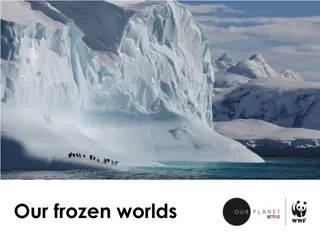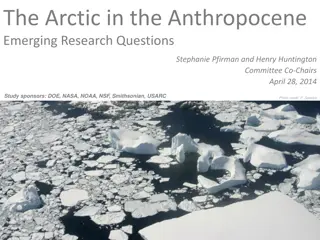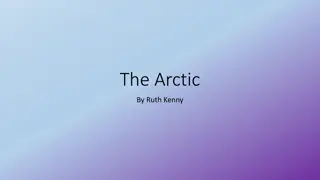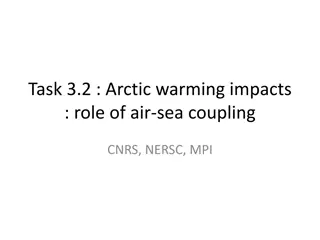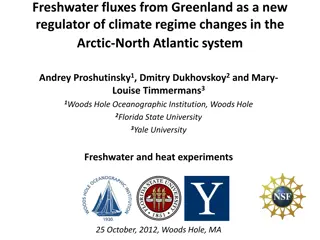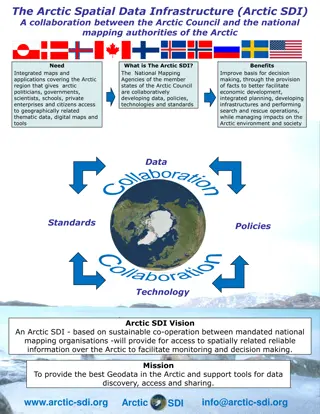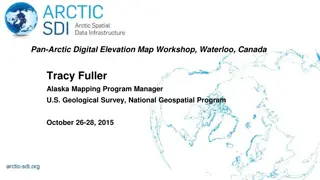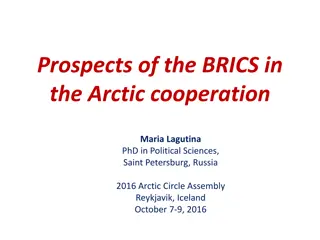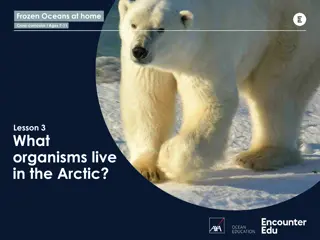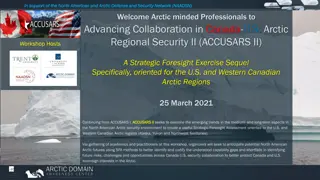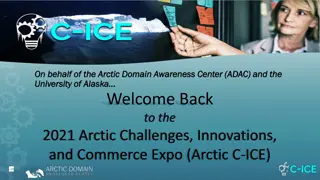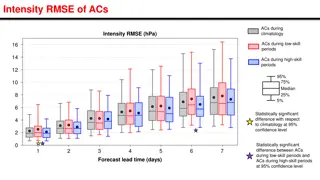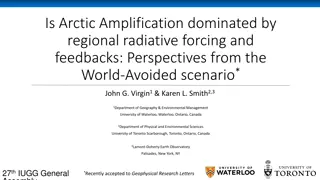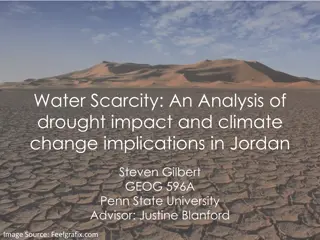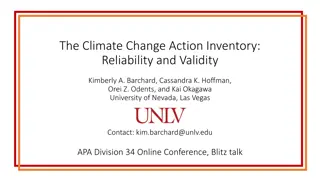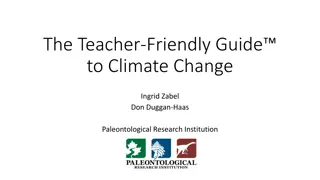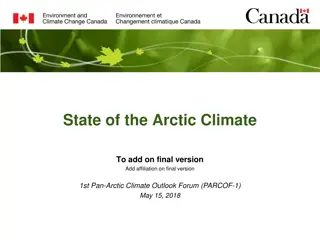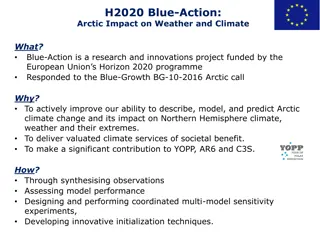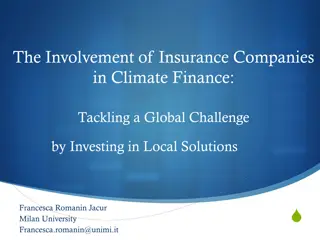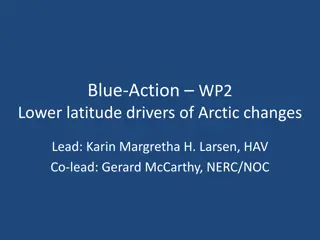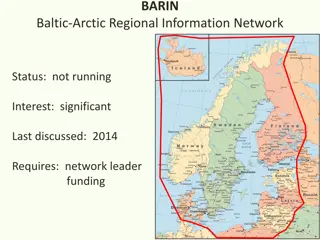Understanding Climate Change: Weather vs. Climate, Kppen-Geiger Classification, and Major Climate Zones
Explore the distinctions between weather and climate, delve into the Kppen-Geiger Climate Classification System, and discover major climate categories such as tropical climates. Gain insights into climate change and its impact on our environment.
8 views • 11 slides
National Climate Change Bill Overview
The National Climate Change Bill aims to establish an effective response to climate change in South Africa, promoting a transition to a low-carbon, climate-resilient economy. It focuses on coordinated actions, adaptive capacity enhancement, greenhouse gas management, and a fair global contribution.
8 views • 21 slides
Gender-based Climate Change Litigation: A Key Solution?
Gender-based climate change litigation is emerging as a potential solution to address the disproportionate impact of climate change on different genders. Various international bodies have recognized the importance of integrating a gender-responsive approach in climate action to uphold human rights,
4 views • 12 slides
Impact of Climate Change on Arctic and Antarctic Regions
Explore the consequences of global warming on our frozen worlds in the Arctic and Antarctica. Learn about the critical role of sea ice, the effects on wildlife like walruses and polar bears, and how changes in the polar jet stream are causing extreme weather events. Discover ways we can combat clima
0 views • 9 slides
Gender and Climate Change in Agriculture: Impacts and Adaptation Strategies
This workshop explores the intersection of gender and climate change in agriculture, emphasizing the importance of considering gender dynamics in adaptation planning. It covers the effects of climate change on men and women in agriculture, reasons for gender-sensitive adaptation planning, global and
0 views • 10 slides
The Arctic in the Anthropocene: Emerging Research Questions
The study sponsored by organizations like DOE, NASA, NOAA, NSF, Smithsonian, and USARC delves into the significant implications of Arctic changes on ecosystems, climate, and humanity. The report emphasizes the urgent need for continued research in the Arctic to understand and address the rapid clima
1 views • 23 slides
Discovering the Arctic: A Wintery Wonderland
The Arctic, located in the northernmost part of our planet, is a captivating region comprising the Arctic Ocean and territories of various countries. Home to unique wildlife like polar bears, snowy owls, and Narwhals, the Arctic also houses indigenous communities such as the Inuits. Learn about iglo
2 views • 7 slides
Understanding the Impact of Arctic Warming Through Air-Sea Coupling
Investigate the role of air-sea coupling in amplifying or dampening the impact of Arctic warming on northern continents using coordinated coupled model experiments. Explore the mechanisms bridging Arctic impacts in the Northern Hemisphere via North Pacific sea surface temperature changes. Focus on t
4 views • 15 slides
Freshwater Fluxes from Greenland and Climate Regime Changes in the Arctic-North Atlantic System
Freshwater fluxes from Greenland are identified as a new regulator of climate regime changes in the Arctic-North Atlantic system. The Arctic Ocean Oscillation Index reveals two circulation regimes with alternating patterns. Correlations between the Arctic Ocean Oscillation and various environmental
1 views • 32 slides
The Arctic Spatial Data Infrastructure (Arctic SDI) Collaboration
The Arctic SDI is a collaborative initiative between the Arctic Council and national mapping authorities of Arctic member states to develop data, policies, technologies, and standards. It aims to provide integrated maps and applications for various stakeholders to access geographically related thema
0 views • 4 slides
Pan-Arctic Digital Elevation Map Workshop Overview
Learn about the Pan-Arctic Digital Elevation Map Workshop held in Waterloo, Canada in October 2015, where discussions revolved around data requirements, project backgrounds, major participants, and the importance of Digital Elevation Models (DEMs) in various Arctic applications. The workshop aimed t
1 views • 18 slides
ARMSDIWG Report: Fifth Year Summary and Future Plans
The ARMSDIWG has highlighted its activities in the fifth year of operation, including meetings, assessments, and collaborations with Arctic SDI and other organizations. Key highlights include assessing the Arctic Voyage Planning Guide, exploring Automatic Identification System services, participatin
0 views • 8 slides
Exploring the GEOTRACES Arctic Program and Its Scientific Objectives
The GEOTRACES Arctic Program aims to study marine biogeochemical cycles in the Arctic region, focusing on trace elements and isotopes. Through international collaboration, the program identifies processes affecting the distribution of key elements in the ocean. The unique Arctic environment, vulnera
0 views • 23 slides
BRICS Engagement in Arctic Cooperation: Opportunities and Challenges
Exploring the evolving role of BRICS countries in Arctic cooperation, this study by Maria Lagutina delves into the prospects, forms, and dynamics of their engagement in the region. From bilateral to transnational cooperation, the analysis examines the participation of major powers like Russia, China
0 views • 11 slides
Exploring Arctic Organisms: Lesson for Ages 7-11
Dive into the enchanting world of Arctic organisms in this cross-curricular lesson for ages 7-11. Discover the unique creatures that inhabit the Arctic region, learn about their interactions and dependencies, and explore the impact of environmental changes on these delicate ecosystems. Engage in act
0 views • 15 slides
Strategic Foresight Workshop for U.S. and Western Canadian Arctic Regions
Welcome Arctic professionals to the ACCUSARS II workshop focused on strategic foresight for the U.S. and Western Canadian Arctic regions. Experts will analyze emerging trends, assess capability gaps, and anticipate future Arctic security challenges and opportunities to enhance Canada-U.S. collaborat
1 views • 11 slides
Arctic Challenges & Innovations Expo: Day 2 Highlights
Explore the key events of Day 2 at the 2021 Arctic Challenges, Innovations, and Commerce Expo (Arctic C-ICE). From insightful fireside chats to discussions on the Blue Economy, the day was packed with engaging sessions. Gain valuable insights from industry experts and thought leaders on transforming
1 views • 9 slides
Arctic Habitat and Polar Bears: A Conservation Perspective
The Arctic habitat, home to diverse plants and animals like polar bears, faces threats such as climate change, toxic pollution, and oil exploration. Despite past population growth, polar bear numbers are now estimated to be between 22,000 to 31,000. Conservation efforts by Scandinavian countries hav
1 views • 6 slides
Understanding Arctic Cyclones and Their Impact on Weather Forecasting
The Arctic environment is undergoing rapid changes, and Arctic cyclones (ACs) play a crucial role in influencing weather patterns in the region. This study explores the intensity and position root mean square error (RMSE) of ACs during different skill periods, highlighting significant differences an
0 views • 32 slides
Regional Radiative Forcing and Feedbacks in Arctic Amplification
Arctic Amplification (AA) is explored in the context of regional radiative forcing and feedbacks in the study by Virgin and Smith (2019). The research investigates the dominance of these factors in the meridional variations of AA, highlighting the contributions of different feedback mechanisms durin
1 views • 22 slides
Progress Summary of ARCTIC WP6 Activities
Continuing the development of the OBPS Arctic Community, WP6 has achieved significant milestones including document organization, peer-reviewed paper submissions, workshop endorsements, and engagement with Arctic Working Groups. Efforts are aimed at advancing Indigenous approaches to ocean observing
0 views • 22 slides
Conservation and Climate Change: Impact on Polar Bears
Learn about the real conditions and future possibilities of climate change on the Arctic, focusing on polar bears and their habitat. Understand how human actions, such as controlling pollution, can make a difference in protecting endangered species like polar bears from extinction due to the melting
1 views • 11 slides
Analyzing Arctic Sea Ice Extent Through Statistics
Explore the use of statistical methods in climate science through the analysis of Arctic Sea Ice Extent data from 1979 to 2012. Understand the significance of September Arctic sea ice and its implications for climate change predictions.
0 views • 30 slides
Using Case Studies to Enhance Climate Services in the Arctic and Beyond
Co-developing climate services through participatory frameworks and case studies is crucial for understanding the impacts of Arctic climate change on global weather patterns. This approach empowers stakeholders by providing tailored knowledge and engaging them in interactive activities to enhance pr
0 views • 11 slides
Understanding Arctic Climate Change Dynamics: A Scientist's Perspective
Atmospheric scientist Catrin Mills, a postdoc fellow at CIRES, delves into the impact of daily weather on Arctic sea ice, exploring its implications for native communities, flora, fauna, stakeholders, and industries. Motivated by coastal inundation and the atmospheric influence on sea ice, she inves
2 views • 11 slides
Climate Change and Development in Africa: A Journey from Kyoto to Paris
The journey of climate change negotiations in Africa, from key milestones in the climate change regime to the role of African institutions and bodies, such as the African Union and African Ministerial Conference on the Environment. Highlights include the entry into force of the UNFCCC, the adoption
1 views • 15 slides
Understanding Drought Impact and Climate Change in Jordan
Analysis of the impact of water scarcity and drought in Jordan, focusing on the most affected areas, implications of climate change, and the Middle East's vulnerability to water insecurity. The research explores the intersection of climate change, water resources, agriculture, and food security, hig
1 views • 24 slides
Life of Arctic Native Americans
The Arctic Native Americans inhabited the Western and Northern coasts along the Bering Sea and the Arctic Ocean, relying on hunting, fishing, and traditional practices for survival in the cold, snow-covered environment. They lived in igloos, wore animal skins for warmth, and belonged to tribes like
0 views • 9 slides
Analyzing Systemic Climate Risk in the Financial Sector
This study discusses systemic climate risk in the financial sector by examining the effects of climate risks on financial institutions. It aims to design a market-based framework to assess the vulnerability of financial institutions to climate risks and analyze potential contagion effects. The frame
0 views • 39 slides
Understanding Climate Change Action: Inventory, Reliability, and Factors
The Climate Change Action Inventory comprises 77 items measuring various actions to combat climate change across eight domains. The method involved 500 MTurk workers, with reliability analyses showing strong internal consistency. Findings indicate a positive correlation between climate change anxiet
1 views • 20 slides
Addressing Climate Change Risks: Guidance for Senior Managers and Board Members
This slide pack tool provides guidance on addressing climate change risks for senior managers and board members. It covers key messages such as understanding obligations and gaps, identifying climate change risks, exploring responsibilities, and implementing actions to address these risks effectivel
0 views • 11 slides
National Priorities for Climate Change Science and Knowledge in Canada
Canadians are experiencing firsthand the impacts of climate change, including wildfires, heatwaves, floods, hurricanes, and droughts. To address these challenges, foundational climate change science and knowledge are essential for understanding our changing environment, identifying impacts, making i
0 views • 9 slides
The Teacher-Friendly Guide to Climate Change
The Teacher-Friendly Guide to Climate Change authored by Ingrid Zabel, Don Duggan-Haas, Robert Ross, and others explores topics such as climate measurement, natural causes of climate change, historical climate perspectives, and more. It delves into the significance of understanding past climates to
1 views • 12 slides
University of Southern Maine - Engaging in Arctic Studies and Collaborations
University of Southern Maine (USM) is a public university with campuses in Portland and Gorham, Maine. USM offers diverse degree programs and engages in various initiatives and projects related to community resilience, Arctic education, and international collaborations. Through the Maine North Atlan
0 views • 4 slides
Insight into the State of the Arctic Climate and Trends
The Arctic climate is rapidly changing, showcasing warmer temperatures and shifting precipitation patterns. The region plays a crucial role in various sectors like shipping, tourism, and economic development, with significant implications for global climate adaptation efforts. Detailed analyses of t
0 views • 12 slides
Blue-Action Project: Enhancing Arctic Climate Prediction and Adaptation
Blue-Action is a Horizon 2020 project focused on improving our understanding of Arctic climate change and its impact on global weather patterns. By synthesizing observations, assessing model performance, and conducting multi-model experiments, the project aims to provide valuable climate services an
0 views • 18 slides
The Role of Insurance Companies in Climate Finance: Addressing Global Challenges through Local Investments
Exploring the engagement of insurance companies in climate finance, this presentation highlights the significance of private sector involvement in tackling climate change at a local level. It delves into key concepts such as mitigation, adaptation, and the global scientific targets for combating cli
0 views • 11 slides
Understanding Lower Latitude Drivers of Arctic Changes in the Blue-Action Project
Blue-Action WP2 focuses on assessing key influences and predictors of Arctic climate changes, emphasizing the importance of sustained observations, AMOC impact, and heat transport. The project involves 20 partners and around 40 scientists, aiming to study interannual to decadal heat anomalies affect
0 views • 15 slides
BARIN Baltic-Arctic Regional Information Network Overview
BARIN, a network focused on environmental monitoring and climate change research in the Baltic-Arctic region, is currently not running but has a significant interest. Established connections with over 50 research institutes and universities. Key areas of interest include carbon flux monitoring, clim
0 views • 7 slides
Enhancing Maritime Resilience to Extreme Weather Risks
Progress in the Blue-Action project focuses on developing climate services for maritime activities, improving risk awareness, and enhancing stakeholder capacity to adapt to climate change impacts in the Arctic region. The project aims to address gaps in understanding severe weather events and their
0 views • 6 slides



